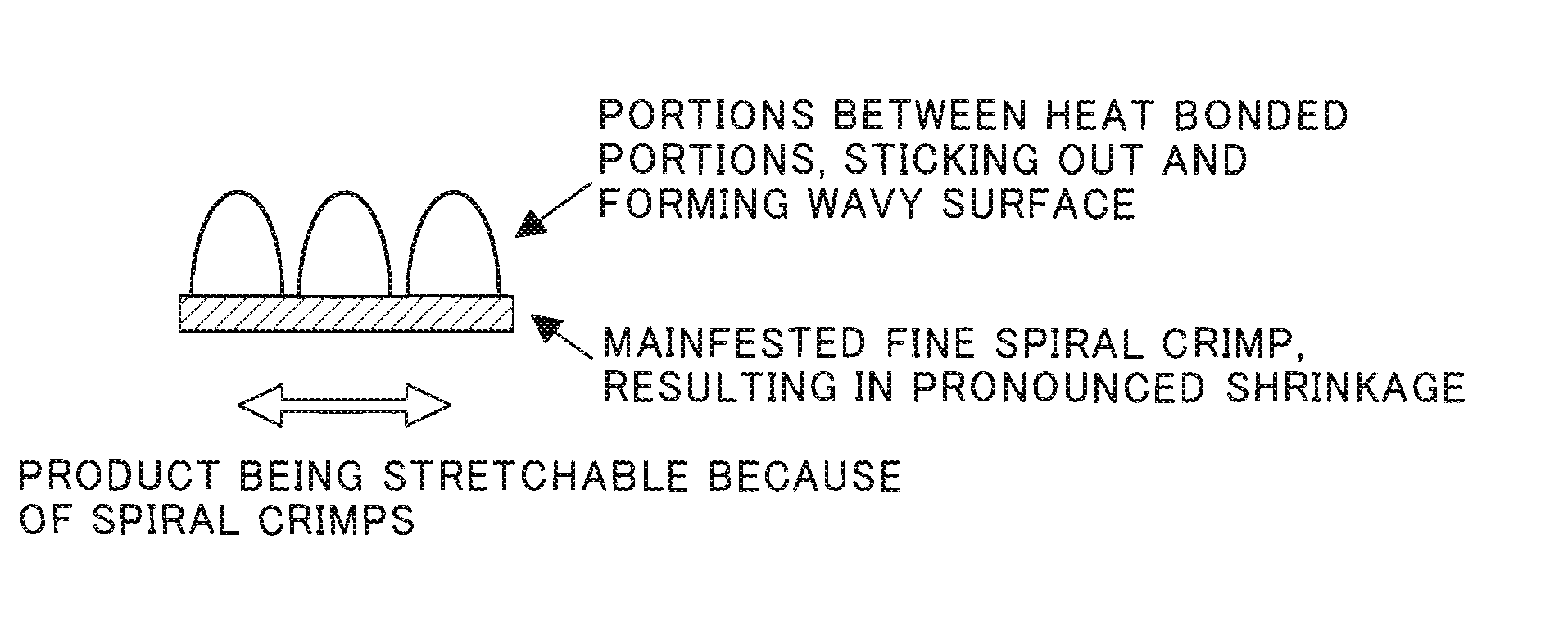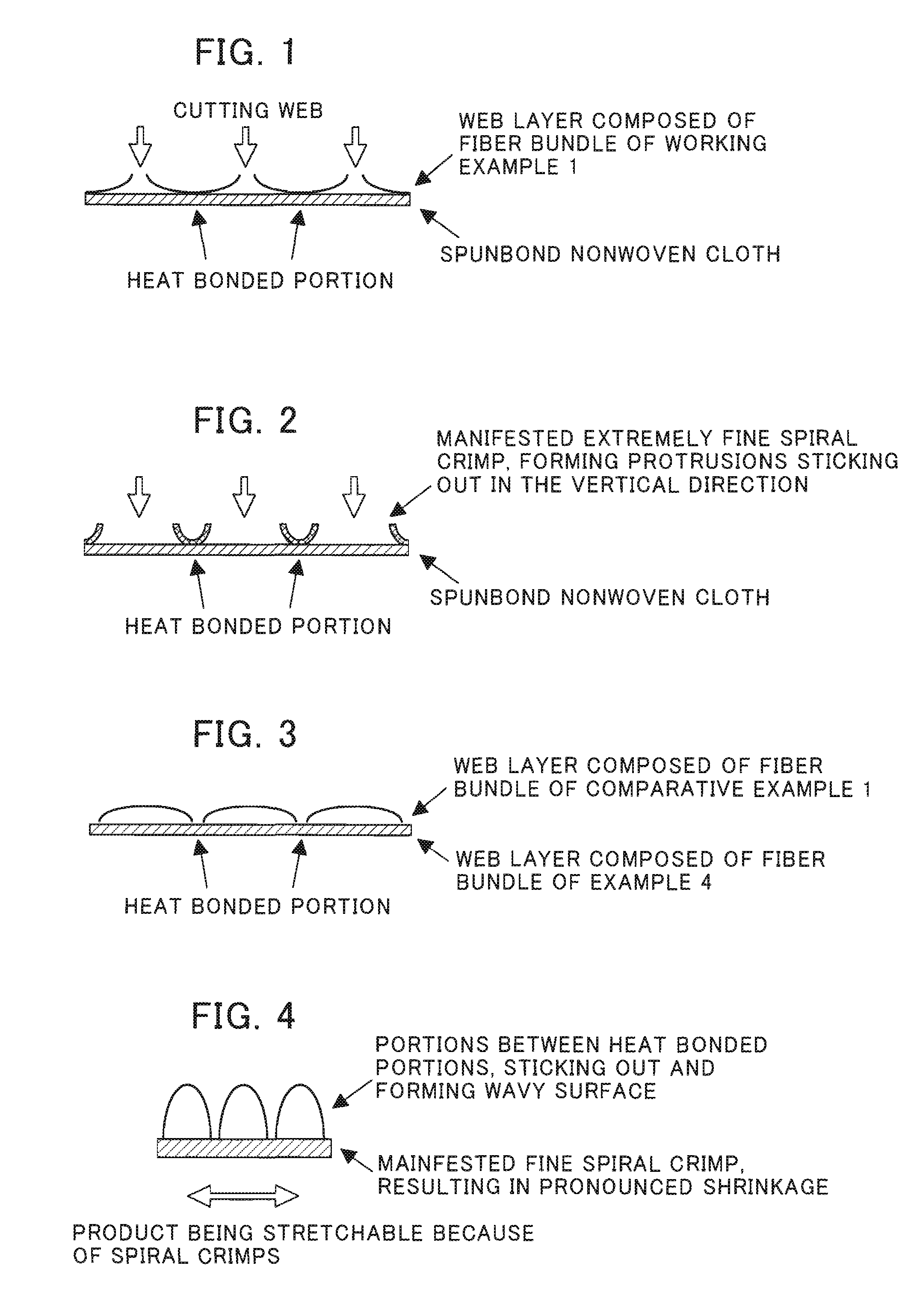Fiber bundle and web
a fiber bundle and fiber technology, applied in the field of fiber bundles, can solve the problems of unsatisfactory methods and significant cost increases, and achieve the effects of high fiber density, easy pulling up, and good touch
- Summary
- Abstract
- Description
- Claims
- Application Information
AI Technical Summary
Benefits of technology
Problems solved by technology
Method used
Image
Examples
working examples
[0095]The present invention will now be described by giving working examples, but is not limited by these examples. Definitions and methods for measuring properties in the working examples are given below.
(1) Single Filament Denier
[0096]Measured according to JIS L 1015.
(2) Single Filament Elongation
[0097]Measured according to JIS L 1015.
(3) Total Denier
[0098]This was calculated from the single filament denier and the number of thermoplastic, conjugate, continuous fibers that made up a fiber bundle or web.
(4) Number of Crimps
[0099]This was measured according to JIS L 1015 for drawn yarns that had been crimped, and the thermoplastic, conjugate, continuous fibers that made up the web.
(5) Fiber Bundle Density and Web Density
[0100]This was calculated from the width and thickness of the fiber bundle or web and the number of constituent thermoplastic, conjugate, continuous fibers.
[0101]The thickness of the fiber bundle or web was measured at a compression load of 0.5 gf / cm2 using a Kato Te...
working example 1
Preparation of Fiber Bundle
[0109]Using high-density polyethylene as the sheath component, and polyethylene terephthalate as the core component, these were conjugated at a volumetric ratio of 50:50, and melt-spun from an eccentric sheath / core nozzle to obtain an undrawn yarn of 7.0 dtex. 25,000 of these undrawn yarns were bundled, and this bundle was drawn to a ratio of 2.0 with a hot roll drawing machine heated to 60° C., and then crimped at 15.2 crimps per 2.54 cm with a high-speed crimper with a width of 20 mm, after which this product was subjected to a drying heat treatment at 100° C., which gave a fiber bundle with a single filament denier of 3.5 dtex / f and a total denier of 86,940 dtex. This fiber bundle had good bundling properties and was easy to pull up, and the fiber bundle density was 960 dtex / mm2. This fiber bundle was spread at 25° C. to a ratio of 1.6, a spiral crimp was manifested in the thermoplastic, conjugate, continuous fibers, which spread out uniformly in the wi...
working example 2
Preparation of Fiber Bundle
[0110]High-density polyethylene and polypropylene were conjugated at a volumetric ratio of 60:40, and melt-spun from a side-by-side nozzle to obtain an undrawn yarn of 14.7 dtex. 11,000 of these undrawn yarns were bundled, and this bundle was drawn to a ratio of 3.0 with a hot roll drawing machine heated to 90° C., and then crimped at 14.0 crimps per 2.54 cm with a high-speed crimper with a width of 20 mm, after which this product was subjected to a drying heat treatment at 100° C., which gave a fiber bundle with a single filament denier of 4.9 dtex and a total denier of 51,842 dtex. This fiber bundle had good bundling properties and was easy to pull up, and the fiber bundle density was 550 dtex / mm2. This fiber bundle was spread at 25° C. to a ratio of 1.6, a spiral crimp was manifested in the thermoplastic, conjugate, continuous fibers, which spread out uniformly in the width direction, and the spreading density ratio was 0.09.
PUM
| Property | Measurement | Unit |
|---|---|---|
| Temperature | aaaaa | aaaaa |
| Temperature | aaaaa | aaaaa |
| Length | aaaaa | aaaaa |
Abstract
Description
Claims
Application Information
 Login to View More
Login to View More - R&D
- Intellectual Property
- Life Sciences
- Materials
- Tech Scout
- Unparalleled Data Quality
- Higher Quality Content
- 60% Fewer Hallucinations
Browse by: Latest US Patents, China's latest patents, Technical Efficacy Thesaurus, Application Domain, Technology Topic, Popular Technical Reports.
© 2025 PatSnap. All rights reserved.Legal|Privacy policy|Modern Slavery Act Transparency Statement|Sitemap|About US| Contact US: help@patsnap.com


